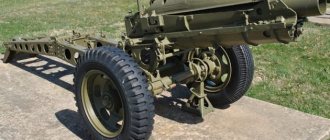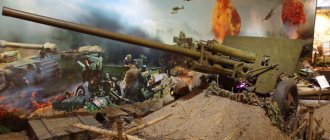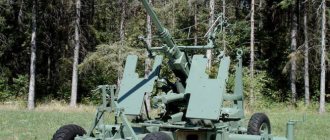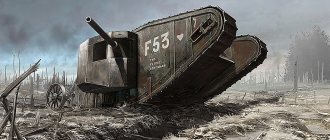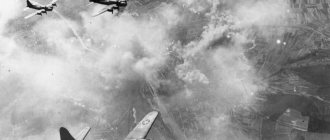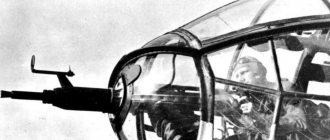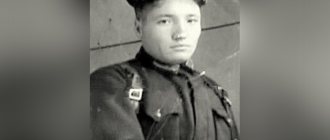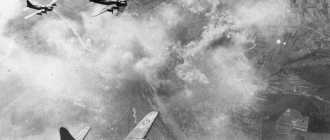British and American rocket artillery of World War II (41 photos)
Author: Ivan Kemerov
05 November 2022 07:23
Tags: American artillery British war rocket
3301
41
We are all accustomed to Katyushas on a car chassis, or at most to guides standing directly on the ground. And here it is! I dug the topic deeper and saw even more interesting and unusual options.
0
See all photos in the gallery
Look here: Work on the creation of combat missiles began in Great Britain in the late 30s. The British military leadership was focused on traditional means of hitting targets on the battlefield (barrel artillery and aviation) and did not perceive rockets as a serious weapon. British military missiles were originally intended exclusively for firing at air targets when the need to improve Britain's air defenses was realized shortly before the outbreak of war. It was decided to compensate for the lack of the required number of anti-aircraft guns with simple and inexpensive rockets. The first developed 2-inch anti-aircraft missile, when launched, dragged behind it a thin steel wire, which, according to the developers, was supposed to become entangled in the propellers of enemy aircraft, thus causing them to fall. There was also an option with 250 gr. fragmentation charge, which had a self-destructor set to 4-5 seconds of flight - by this time the rocket should have reached an estimated altitude of about 1370 m. A small number of 2-inch rockets and launchers for them were fired, which were used exclusively for educational and training purposes . A 3-inch anti-aircraft missile, the warhead of which had the same mass as a 94-mm anti-aircraft projectile, turned out to be more promising. The rocket was a simple tubular structure with stabilizers; the engine used a charge of smokeless powder - SCRK brand cordite, already used in the 2-inch rocket. The rocket weighing 25 kg had a ceiling of about 6500 m.
0
The missiles and single-shot launcher were successfully tested in 1939. In the same year, serial production of missiles and launchers began.
×
0
Missile launches from these early installations were not always reliable, and their accuracy was so poor that only barrage anti-aircraft fire was possible. Soon, to increase the likelihood of hitting an air target, a installation with two guides was adopted. Subsequently, the efficiency of anti-aircraft rocket launchers was increased by increasing the number of missiles on launchers and improving proximity missile fuses.
0
Mobile installations were created on a carriage of 3-inch anti-aircraft guns, which from 36 rail guides could fire volleys of 9 missiles. And the most powerful was a stationary coastal defense installation, firing 4 salvoes of 20 missiles, which came into operation in 1944. 3-inch rockets proved to be much more effective as aircraft weapons. During the war, 3-inch rockets were used from aircraft to combat armored vehicles and even to sink German submarines on the surface.
0
Some Cromwell tanks were equipped with two 3-inch anti-aircraft missiles mounted on rails along the sides of the tank turrets. There have also been attempts to install such launchers on armored vehicles.
0
Beginning in 1944, the Allies began to push back the Japanese in Asia. Fighting in the jungle was characterized by relatively short firing distances and often the inability to bring up artillery to destroy Japanese pillboxes.
0
To solve this problem, a reactive system was developed, which became known under the code name LILO. The launch device was carried to the firing position by one person, and the second carried the rocket in a backpack. Upon arrival at the site, the missile was inserted into the tube from the front, the elevation angle was adjusted by the rear support legs, and guidance was carried out through an open sight. The launch was carried out remotely using an electric igniter from a 3.5 V battery.
0
There were two modifications of this weapon: 83 mm - weighing 17.8 kg carried 1.8 kg of explosives, and 152 mm - weighing 35 kg carried 6.24 kg of explosives. LILO were capable of entering the ground to a depth of 3 m, also breaking through log flooring, which was enough to destroy any Japanese bunker. The development of jet weapons in Great Britain was primarily focused on air defense, but in anticipation of the inevitable Allied landing on the Atlantic coast, a light weapon capable of producing a high density of fire in a short period of time was required. Structurally, this was realized by connecting the rocket engine of a 3-inch aircraft rocket with a 13-kg warhead of a 127-mm artillery shell. To increase firing accuracy, the missiles were spun from screw guides when launched.
0
0
The launchers were installed on landing ships for fire suppression in the landing area. The naval system received the original name “Mattress”. The land version of this installation became the “Land Mattress”. Army towed launchers had 32 barrels and an elevation angle: from 23° to 45°, a maximum firing range of up to 7225 m. Later, 24-charge lightweight installations were created. Fire control was carried out using a remote control. During the march, the installation was towed by a regular army truck.
0
The first British "Land Mattress" were used in Sicily in 1943. These installations especially distinguished themselves during the crossing of the Scheldt River and the assault on Walcheren in 1944, after which several more artillery rocket batteries were created.
0
The installations arrived in significant quantities to the troops only at the beginning of November 1944, so they no longer had a serious impact on the course of hostilities. Attempts to use the Land Mattress in Burma were not very successful due to low mobility. Installations on a self-propelled chassis were required, but the developed launchers on a jeep chassis were too late for the war. Missiles from the Hedgehog naval anti-submarine bomber, which was developed in Great Britain and installed on many British and American warships, were used against ground targets.
0
In the photo: Hedgehog bomber. The 178-mm projectile, upgraded for firing along the coast, with an increased firing range, contained up to 16 kg of Torpex, which guaranteed the destruction of any field fortification or anti-landing barrier upon impact. There was also an incendiary version, which, upon explosion, covered everything within a radius of 25 meters with burning white phosphorus.
0
Mousetrap anti-submarine bomb launcher (USA). Bombers with modernized rockets were used both from landing ships to “clean up” the coast and were installed on Matilda tanks.
0
"Matilda" armed with an anti-submarine bomb launcher - Matilda Hedgehog, is on display at the Australian Museum in Puckapunyal. A Hedgehog bomb launcher is installed at the rear of the vehicle. . The Americans began developing their own missiles almost simultaneously with the British, however, the result was much better. During the course of the war, several different types of 4.5 in (114 mm) rockets were developed and put into production. The most popular was the M8 aircraft jet projectile, developed for arming attack aircraft and produced since 1943, weighing 17.6 kg; it had a length of 911 mm and a caliber of 114 mm.
0
In the photo: M8 rocket. In addition to US attack aircraft, M8 shells were also actively used by ground forces, mounting multi-barrel launchers on tanks, trucks, jeeps and armored personnel carriers, and in the navy - on ships. Despite the “aviation orientation” of the M8 missiles, ground forces and the navy spent several times more of these missiles, using them from multi-barreled multiple rocket launchers. In 1943, the T27 Xylophone unit entered service with the US Army. The units, arranged in a single row, were mounted on modified 2.5-ton GMC CCKW-353 6x6 or Studebaker truck chassis. In terms of accuracy, firing range and salvo power, they were inferior to the Soviet BM-13.
0
In the photo: American MLRS T27 Xylophone. Lighter installations have also been developed in the USA. As a base, modified chassis of off-road vehicles such as Willys or Dodge “three-quarter” WC51 were used.
0
At the rear of the vehicle, pipes for 28 unguided rockets were installed in two rows. The most famous American MLRS was the T34 CALLIOPE.
0
The M4 Sherman medium tank served as the basis for the rocket system. A package of 60 tubular guides for 4.5-inch (114 mm) M8 missiles was mounted on its turret. The weight of the salvo was 960 kg, the maximum firing range was 3800 m, the salvo time was 15-20 seconds. The horizontal guidance of the rocket launcher at the target was carried out by the crew commander by turning the turret. Vertical aiming was carried out by raising or lowering the gun barrel, to which a package of guides was connected by means of a rigid rod. The total weight of the installation was about 1 ton.
0
Reloading the system on the battlefield was very problematic, and therefore it was simply thrown off the tank immediately after a salvo. To do this, only one electrical connector was disconnected and three bolts were knocked out with a sledgehammer. Subsequently, the installation was modernized and it became possible to get rid of it without the crew leaving the tank.
0
A common tactic was massive shelling of enemy positions in order to suppress anti-tank weapons from an MLRS mounted on top of the tank's turret. After which the crew quickly got rid of the launcher and went on the attack on a par with conventional linear vehicles. Taking into account the usually “disposable” use of the launcher, plastic and cardboard guides for missiles were subsequently adopted.
0
There were several versions of these installations, which were popular among the troops and were actively used in battles. Faced with numerous, often very sophisticated Japanese fortifications and firing points during the battles for the atolls, the Americans hastily created and adopted a single-shot M12 launcher for 114-mm M8 rockets, similar to the British LILO. Both plastic, disposable launchers and reusable magnesium alloy launchers were used. However, the weight of the warhead of the 114-mm M8 projectile did not exceed 2 kg, and the installation’s effectiveness against protected targets was often insufficient. The most “multi-barrel” were the T44 launcher with 120 “tubes”, on the loading platform of a DUKW amphibious truck or LVT amphibious vehicle, and the “Scorpion” launcher with 144 barrels, based on the DUKW amphibian. The American Navy and Marines actively used 114-mm shells of the 4.5″BBR type (BBR - Beach Barrage Rocket - a missile for the destruction of coastal structures).
0
4.5″BBR rocket. The 4.5″BBR rocket had a caliber of 114.3 mm, its length was 760 mm, and its weight was 13 kg. A powder propellant charge weighing 6.5 kg provided a maximum projectile speed of 233 m/s, and the firing range was about 1 km. The warhead contained 2.9 kg of trinitrotoluene; its effect was comparable to a 105-mm howitzer high-explosive fragmentation projectile. Ship-based launchers for 4.5″BBR shells were packages of honeycomb guides mounted on the deck of landing fire support ships at an angle of 45° to the horizon. Each of these ships could fire several hundred rockets in a matter of seconds, ensuring the destruction of enemy defenses and manpower on the shore. In 1942, ship-based launchers were used during the landing of Allied forces in Casablanca, and since 1943 they have been widely used in amphibious operations on the Pacific islands.
0
Improvised 4.5″BBR rocket launcher. The first land launchers for 4.5″BBR projectiles were improvised grooved wooden guides that the US Marines used to harass Japanese positions.
0
Division of American 4.5″BBR rocket launchers on trucks
0
Also, the simplest launchers were mounted on light all-terrain vehicles; targeting was carried out by turning the vehicle accordingly. The shooting was controlled using a remote control. Absolutely all launchers of 4.5″BBR rockets had a large dispersion when firing and could only be used for striking areas. However, sailors and marines had no shortage of ammunition: during the war years, the United States produced more than 1,600,000 4.5″BBR missiles. Despite their fairly widespread use, the available rocket munitions did not satisfy the American military in terms of accuracy and power at the target. In this regard, the Americans switched to the principle of stabilizing missiles by rotation. The 4.5-inch M16 rocket had a length of 787 mm and a mass of 19.3 kg, including 2.16 kg of rocket fuel and 2.36 kg of high-explosive explosives. Its initial speed was 253 m/s, the maximum flight range was 4805 m. Its stabilization in flight by rotation around the longitudinal axis is ensured by a turbine screwed into the bottom of the powder engine, which has 8 gas nozzles inclined to the axis of the projectile. The M16 missiles no longer entered service with American aviation, being purely ground-based for multiple launch rocket systems.
0
T66 towed launcher. The T66 towed launcher was developed specifically for this missile. It consists of 24 aluminum tubular guides combined into a package mounted on a two-wheeled carriage with sliding frames.
0
0
In the vertical plane, aiming is provided in the range of angles from 0° to +45°, in the horizontal plane - within 20°. The launcher was loaded from the muzzle. The weight of the launcher without shells is 556 kg. This made it possible to use Willys-type all-terrain vehicles for transportation. Firing from the installation was carried out using a remote control.
0
The dispersion of the shells was relatively small. It took about 90 seconds to fully equip the T66 installation with missiles. The T66 launcher, in terms of its totality of characteristics, was the most advanced American MLRS used in World War II, but it was used only in the final stages of hostilities, and in very small quantities. In 1943, the United States adopted the 182 mm (7.2 inch) Ml7 unguided rocket, intended primarily for the destruction of long-term defensive structures. The length of the Ml7 projectile was 880 mm, the total weight was 27.5 kg. During engine operation, the projectile accelerated to a speed of 210 m/s, the firing range was approximately 3.2 km. There was also an improved version of this projectile - M25. It had a head of a different design, the length of the projectile was increased to 1250 mm, and the weight was 26 kg. Compared to 114 mm rockets, the new projectiles had a shorter range and a more powerful high-explosive fragmentation warhead.
0
The T40 launcher for twenty M17 rockets was also mounted on the Sherman, similar to the T34 CALLIOPE MLRS. The installation consisted of 20 honeycomb type guides. The package of guides itself had armor protection, and in its front part the protection was made in the form of armor flaps that fold up and down.
0
T40 launchers were first used in 1944 during the landing of Anglo-American troops in Normandy, and they were also used in battles in Northern Italy. When assessing the Anglo-American MLRS, it is worth noting that, unlike the USSR and Germany, they were never considered by the Allied armies as an important means of engaging the enemy by fire. This can be explained by the overwhelming superiority over German troops in classical means: cannon artillery and aviation. In terms of their combat characteristics, American, and especially British, rockets were significantly inferior to those used by Soviet and German artillerymen. This was reflected in the tactics of their use: British and American MLRS very rarely fired at enemy rear lines, usually limiting themselves to providing direct fire support to their advancing units.
0
English armored car T17E1 "Steghound" with missile weapons, France 1944
0
0
0
0
0
0
Installing a 5-Inch FFAR missile under the wing of an F-4U Corsair
0
Loading 5-Inch FFAR missiles onto a ship-based launcher
0
Source:
Related links:
- Australian photographer captures the harsh truths of life on the front line
- What would a modern nuclear war be like?
- An American bought a tank for 600 thousand dollars and enraged his neighbors
- Poles died while trying to defuse a shell in a fire
- Horrible pages of history: brothel in Auschwitz
Tags: American artillery British war rocket
Did you like the post? Support Chips, click:
101 12 89
Liked
89 2
8
Partner news
Beginning of work
The Kurchevsky recoilless rifles, which the restless designer tried to attach everywhere: from destroyers to airplanes, were to become the Soviet prodigies. Yes, their rate of fire was not amazing, but they had a caliber that was mind-blowing for an aircraft weapon: 76 mm. True, the ballistic characteristics of the guns did not shine. The low initial speed meant both low accuracy and difficulty in aiming.
However, they even went into mass production.
Another possibility was to arm the aircraft with rockets - rockets. The USSR, of course, was not the “homeland of elephants” - in the sense of aircraft missiles - they were used by the French during the First World War, but in the 30s few people carried out work in this direction.
For the weapon to be effective, it was necessary to ensure acceptable accuracy and range, and there were problems with this.
However, Soviet designers were attracted by the prospects of aircraft missiles. Firstly, the amount of explosives delivered by the rocket was attractive. The RS-82, which was tested in 1936, carried 370 grams (according to other sources, even 380) of explosives with a total mass of 6.35 kilos - quite comparable to a three-inch shell from a divisional gun. Secondly, range. It was intended to use the RS at long distances - 1500 meters or more. This made it possible to get out of the effective fire range of the defensive weapons of the bombers.
Unfortunately, the fuse used on the RS only provided detonation at a distance of 1500 meters. After the launch, the spinner fuse ignited the remote tube, and after five seconds it detonated the projectile. It was not possible to set the fuse at a different time.
Worse, the pilot had virtually no way of determining where exactly the explosion would occur. The distance of 1500 meters was determined based on the assumption of an average speed of 300 m/s of the projectile itself. But the actual speed depended not only on temperature, wind and other external parameters, but also on the speed of the aircraft from which the launches were made.
